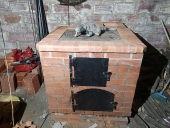My guess is the addition of oxygen feeds/sustains the combustion and increases the energy
a little science about combustion:
Burning is a 3 step process
1: solid cannot burn, it must first be thermally cracked and then evaporate to gaseous form. This all happens when lit. And once the fire is lit, the energy from the fire keeps this process going.
2: All carbon burns to CO (carbon monoxide) first
3: CO burns further to CO2 (carbon dioxide), under the condition of still sufficient O2 (oxygen) and a temperature higher than about 400-450 degrees Celsius / 752-842 Fahrenheit for a minimum duration of 2 seconds.
In step 3 you would like to add oxygen. The cheapest source of this is ambient air. How much? If you were to measure oxygen in your chimney, you could control for 4% residual oxygen in your exhaust gas. Why no stoichometric combustion and control on 0% residual oxygen? Balance issue: At less than 4% oxygen, not all CO will burn through to CO2, and there may be too much CO in your exhaust gases. Toxic and less efficient combustion.
Is more secondary air better? Certainly not! For 2 reasons:
1: Added air must also be heated (remember minimum temperature at 3th combustion step). This will lower the temperature of the combustion gases with the chance that the CO will not burn through to CO2 and therefore slightly less combustion energy from your fuel.
2: Larger flue gas volume, so more chimney losses at the same exhaust temperature.
Vortex or no vortex?
The vortex provides a slightly longer path in the riser pipe at a slightly higher pressure. So more certainty about a good mixing of oxygen and fuel....combustion rooms of many power plants are designed in this way. (burners placed tangentially in round combustion chambers).
I have no experience with rocketstoves, but I hope more people understand the combustion process now.











